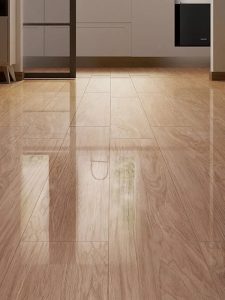
How to detect the quality of wood grain tiles?
1. It can be tapped, and the sound is clear, indicating that the ceramic tile has high density and hardness, and good quality (if the tile makes a “pop, pop” sound, it means that its sintering degree is not enough, and the texture is inferior. If there is a slight “dong dong” sound, its texture is relatively hard compared to the previous one), (actually, the method is very simple. Knock it with your hands, and the high-density tiles will have a crisp fragrance of glass. Density tiles make a dull brick sound.)
2. Measure the water absorption rate of the tiles. The lower the water absorption rate, the higher the internal stability of the tiles, and the more suitable for spaces with high moisture or moisture content (such as bathrooms, kitchens), and there will be no problems such as black spots.
3. Pour a glass of water on the back of the tile, the water stain spreads rapidly, indicating that the water absorption rate is high, and vice versa.
4. You can scrape the glazed surface of the tile with a hard object. If traces are left, the quality is poor.
5. Check whether the color of the tiles is clear or not, and see if there are pinholes with the naked eye. The pinholes are easy to accumulate dirt.
6. The flatness of the tile, the side is straight, it is easy to lay, and the effect is good (visual method, place the floor tile on the flat surface to see if the four sides of the tile are completely consistent with the flat surface, and check whether the four corners of the tile are all right angles. , and then place the tiles in the same variety and type of tiles to observe the degree of color difference).
7. When choosing floor tiles, it is often seen that material dealers step on the ground hard, which can only mean that the bottom of his floor tiles is flat but not that his tiles are of good quality.




